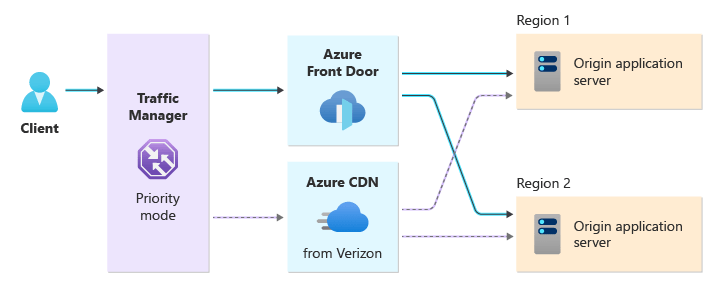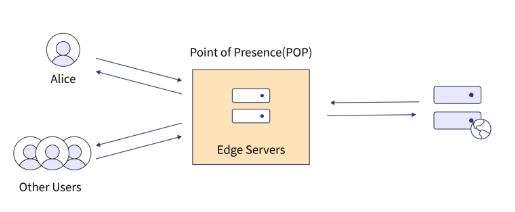
- Introduction to Azure CDN
- Benefits of Using Azure CDN
- How Azure CDN Works
- Types of Azure CDN (Microsoft, Verizon, Akamai)
- Setting Up Azure CDN in the Azure Portal
- Configuring Custom Domains and SSL for Azure CDN
- Integrating Azure CDN with Azure Storage, Web Apps, and Media Services
- Caching and Content Optimization in Azure CDN
- Managing and Monitoring Azure CDN Performance
- Conclusion
Introduction to Azure CDN
Azure Content Delivery Network (CDN) is a worldwide service that delivers high-performance and scalable content for websites, applications, and media. It enables content like images, videos, scripts, and other assets to be cached in various locations worldwide, lowering latency and enhancing end-user load times. With Azure CDN, companies can deliver content quickly and reliably across different geographic locations, making it perfect for performance-critical applications and large-scale sites. To maximize the benefits of this service, organizations can invest in Microsoft Azure Training to gain deeper insights into optimization techniques, security best practices, and cost management strategies. Azure CDN works natively with other Azure offerings, including Azure Storage, Azure Web Apps, and Azure Media Services, allowing straightforward content delivery and performance optimization management. Whether you need to deliver content to users in a particular region or the entire world, Azure CDN gives you the capabilities to scale, secure, and optimize content delivery.
Benefits of Using Azure CDN
- Increased PerformanceThrough the caching of content at strategically placed edge servers, Azure CDN shortens the physical distance between the server and the end user. This decreases latency and results in quicker content delivery, resulting in an improved user experience and lower load times for websites and applications.
- Worldwide Reach Azure CDN employs a worldwide network of edge locations so that users anywhere in the globe can access content with minimal latency. The CDN is hosted at hundreds of points of presence (PoPs) on different continents, and enterprises can serve the global audience through optimized delivery.
- Scalability Azure CDN offers auto-scaling to accommodate changing traffic levels. Whether you’re dealing with an influx of users based on a new product launch or high-volume web traffic, Azure CDN can scale automatically without the need for manual intervention to meet your requirements.
- Offloading Origin Server Load With caching controls, Azure CDN offloads the load on your origin servers by delivering cached content directly from edge nodes. This decreases the requests to your origin server, enabling it to accomplish more critical tasks and enhancing overall performance. Additionally, Data analytics with azure stream , you can gain real-time insights into content delivery, monitor CDN performance, and optimize caching strategies dynamically.
- Increased Security Azure CDN pairs with Azure security features like DDoS protection, Web Application Firewall (WAF), and SSL/TLS encryption to protect content delivery. It ensures secure delivery of your content and guards against malicious threats, unauthorized access, and data tampering.
- Cost-Efficiency By delegating content delivery to the CDN, companies can decrease traffic reaching their origin servers, saving infrastructure and bandwidth costs. Also, Azure CDN’s pay-as-you-go pricing model allows customers to pay only for the resources they consume, making it an economical and flexible option.
- Smooth Integration with Azure Services Azure CDN integrates with other Azure products, such as Azure Storage, Web Apps, Media Services, and more. This allows for streamlined and converged content delivery without the need for third-party tools or configurations.
Eager to Acquire Your Microsoft Azure Certification? View The Microsoft Azure Training Offered By ACTE Right Now!
How Azure CDN Functions
Azure CDN functions by serving cached content in many edge locations across the globe. When a user requests content (e.g., a webpage or video), the CDN will look in its closest edge server for the requested content. The CDN will deliver the content directly from the edge if it is cached. If the content is not cached, the CDN will retrieve it from the origin server (e.g., Azure Storage, Web Apps) and cache it for future requests. This provides content efficiently and rapidly with as little latency as possible. Azure CDN caches static content such as images, JavaScript files, stylesheets, and videos. This lowers the workload on origin servers and accelerates end-user content delivery. As part of Microsoft Azure Training , understanding how Azure CDN optimizes performance and reduces latency is essential for building scalable cloud solutions. Azure CDN employs a network of edge locations and geographically distributed data centers that cache content near end-users. Edge servers maintain copies of popularly requested content to ensure that assets are delivered quickly and efficiently. The CDN is guided by cache control headers set by the origin server. These headers indicate how long content is cached at edge sites and when it should be updated. Companies can keep their content current by managing cache expiration while maximizing cache hit ratios. Whenever a user asks for content, the Azure CDN checks the edge location nearest to them. If the content is already cached, it is delivered instantly. Otherwise, the CDN fetches the content from the origin server, caches it in the edge location, and pushes it to the user. Content held in the edge locations is cleaned out periodically according to cache expiration policies or when it is refreshed. Azure CDN offers mechanisms to clean out content from the cache when required so users can get the freshest content.

Types of Azure CDN (Microsoft, Verizon, Akamai)
Azure CDN has several content delivery providers, each with advantages and capabilities. The three most common types of Azure CDN are:
- Microsoft CDN – This is the standard CDN offering for Azure, offering an easy and affordable solution for content delivery. It is optimized for Azure services and includes global reach with low-latency access.
- Verizon CDN – Verizon’s CDN service is highly reliable and offers high performance. It includes traffic routing that is intelligent and sophisticated caching strategies, which is well-suited for businesses with high availability needs and global outreach. Verizon’s CDN performs very well for streaming media and large file downloads.
- Akamai CDN – Akamai is one of the world’s largest and most widely adopted CDNs. With its extensive network of edge locations and advanced security features, Akamai’s CDN offering is well-suited for enterprises that need a robust, high-performance solution for their global content delivery needs. Akamai excels in handling high-volume traffic and streaming applications.
Setting Up Azure CDN in the Azure Portal
Create a CDN Profile
- Sign in to the Azure Portal and click “Create a resource.”
- Search for “CDN” and choose “CDN Profile.”
- Select a subscription or resource group, and input a name for your CDN profile.
Create a CDN Endpoint
- After creating a CDN profile, create a CDN endpoint. An endpoint specifies the origin of the content, such as an Azure Storage account, Web App, or custom server.
- Provide the endpoint name, origin type (e.g., Azure Blob Storage), and the origin URL.
- Configure cache control rules to define how content is cached at edge points. You can specify cache expiration periods or create custom caching rules based on content types.
- You can set up a custom domain for your CDN endpoint.
- You can also set up SSL for secure content delivery over HTTPS by setting up SSL certificates in the Azure Portal.
- Custom Domain Setup Go to your CDN profile in the Microsoft Azure portal and choose the endpoint. Under the “Custom domains” heading, add a custom domain and set up the required DNS settings to point to the CDN endpoint.
- SSL Setup Azure CDN offers SSL/TLS encryption for the delivery of secure content. To enable SSL, you may utilize a default Azure-provided certificate or upload your own custom certificate.
- Azure Storage Azure Blob Storage can be utilized to originate content. After the content is uploaded to Azure Storage, the CDN caches it at edge sites and serves it to end-users globally.
- Azure Web Apps Azure CDN can be used with Azure Web Apps to serve static content like images, JavaScript, and CSS files. This offloads the load from your web server and enhances the performance of your website or application.
- Azure Media Services Azure CDN is used with Azure Media Services to serve streaming media content. This enables businesses to serve high-quality audio and video content with minimal latency to end users worldwide.
- Azure Monitor – Tracks key metrics like cache hit ratio, response time, traffic volume, and error rates to diagnose issues and optimize delivery.
- CDN Analytics – Big data analytics offers real-time insights on cache hit/miss rates, bandwidth usage, request rates, and geo-analytics for better content distribution.
- Alerts – Set up notifications for performance thresholds, traffic spikes, SSL expiry, and origin server failures to proactively address issues.
- Third-Party Integration – Connect with tools like New Relic, Datadog, or Power BI for advanced monitoring and security enhancements.
Interested in Obtaining Your Microsoft Azure Certificate? View The Microsoft Azure Online Course Offered By ACTE Right Now!
Configure Caching Rules
Custom Domains and SSL
Configuring Custom Domains and SSL for Azure CDN
Azure CDN enables you to use custom domains to serve your content. This ensures consistency in branding and gives a more improved user experience. Below is how you can set up custom domains and SSL:
Cloud Computing Master’s Degree in Cloud Computing? Enroll For Cloud Computing Master Certification Today!
The SSL certificate helps secure the data being shared between the end user and the edge server by encrypting the data to ensure a secure connection. For those looking to deepen their knowledge, Microsoft course cover CDN configurations, optimization techniques, and best practices for leveraging Azure’s global infrastructure. These courses help professionals understand how to enhance performance, improve scalability, and integrate Azure CDN with other cloud services. Integration of Azure CDN with Azure Storage, Web Apps, and Media Services Azure CDN seamlessly integrates with various Azure services to deliver optimized content:

Caching and Content Optimization for Azure CDN
Azure CDN incorporates multiple caching systems and optimization options to enhance the delivery of content. Utilize cache control headers to specify a duration for how long content gets cached. Schedule expiration times so fresh content is delivered to users while reducing cache hit times. While Azure CDN is geared towards static content, dynamic content caching is also supported. Dynamic content like user-specific information can be cached at the edge for lower latency. Allow automatic content compression, such as text files, to make file sizes smaller and download faster.
Set to Ace Your Microsoft Azure Job Interview? Check Out Our Blog on Microsoft Azure Interview Questions & Answer
Managing and Monitoring Azure CDN Performance
Conclusion
Azure CDN is a powerful solution for enhancing content delivery performance, scalability, and security. By leveraging Azure CDN, businesses can ensure faster load times, reduced latency, and a seamless user experience for customers across the globe. Its integration with Azure services like Storage, Web Apps, and Media Services further simplifies content distribution while optimizing costs. To fully utilize Azure CDN, it is crucial to implement best practices such as caching optimization, compression, and proactive monitoring. By configuring custom domains, SSL certificates, and caching rules effectively, businesses can ensure secure and efficient content delivery. Additionally, Microsoft Azure Training , along with leveraging Azure’s built-in analytics and cost management tools, helps in monitoring performance and optimizing expenses. With its global reach, security features, and flexibility, Azure CDN is an ideal choice for organizations looking to deliver content quickly and reliably. By following the recommended setup, optimization techniques, and best practices, businesses can maximize the benefits of Azure CDN and provide a superior digital experience to their users.





